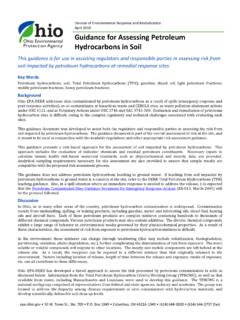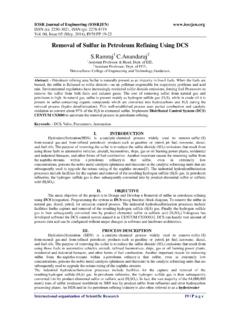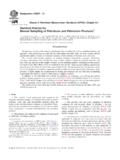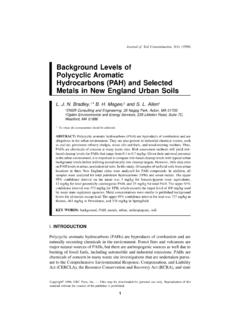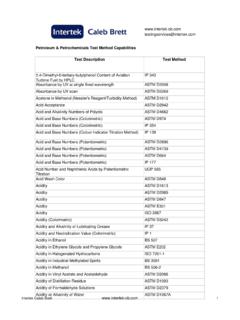Transcription of Extractable Petroleum Hydrocarbon Fractions Using the …
1 Extractable Petroleum Hydrocarbon Fractions Using the ETPH Analytical Method and Criteria Development TECHNICAL SUPPORT DOCUMENT connecticut Department of Energy and Environmental Protection connecticut Department of Public Health July 2012 ETPH Method i Contents List of Tables .. i Background and Analytical Considerations .. 1 Extractable Petroleum Hydrocarbon Fractions Using the ETPH Analytical Method and Criteria 3 Summary of Recommended Criteria Values .. 4 APPENDICES .. 1 Appendix A .. A-1 Appendix B .. B-1 Appendix C .. C-1 List of Tables Table 1 Analytical Method for Petroleum Hydrocarbons Table 2 Analytical Reporting Levels per CT RCP Method Documents Table 3 Proposed Remediation Criteria for Use with the ETPH Method Table B-1 Calculation of Residential Groundwater Volatilization Criteria Table B-2 Calculation of Industrial/Commercial Groundwater Volatilization Criteria Table C-1 Calculation of Surface Water Protection Criteria Table C-2 Calculation of connecticut Tier 2 Chronic Aquatic Life Criteria Table C-3 Data Used to Derive Aquatic Life Criteria for Decane Table C-4 Data Used to Derive Aquatic Life Criteria for Cyclododecane ETPH Method Page 1of 5 Background and Analytical Considerations The connecticut Remediation Standard Regulations, Sections 22a-133k-1 through 22a-133k-3 of the Regulations of connecticut State Agencies (RSRs)
2 , contain environmental criteria to facilitate the assessment and remediation, as necessary, at sites within connecticut which have been affected by releases of various substances. Within the regulations promulgated in 1996, criteria were established for certain individual semi-volatile substances commonly associated with releases of Petroleum Hydrocarbon mixtures in addition to criteria for Total Petroleum Hydrocarbons (TPH) as a complex aggregate of substances as reported by the United States Environmental Protection Agency (EPA) Method , which utilized Freon-111. In an effort to help bring about the end of Freon use in connecticut and to be consistent with Federal Law, the connecticut Department of Energy and Environmental Protection (DEEP) stopped accepting analytical data derived by EPA Method for samples collected on or after June 30, 2009. In addition, the Environmental Laboratory Certification Program of the connecticut Department of Public Health stopped offering certification for EPA Method as of September 30, 2009 and after this deadline laboratories may not use EPA Method Since the TPH remediation criteria in the regulations were method specific, and laboratories could no longer use EPA Method , this effectively prevented the use of the promulgated criteria from use at remediation sites for samples collected on or after June 30, 2009.
3 Since 1999, another analytical method has been available for use in connecticut to evaluate Petroleum hydrocarbons as a complex mixture of aggregate of substances. This method is titled "Analysis of Extractable Total Petroleum Hydrocarbons Using Methylene Chloride Gas Chromatograph/Flame Ionization Detection (ETPH Method)," prepared by the Environmental Research Institute, University of connecticut , dated March 1999 and approved by the Commissioner of the State of connecticut Department of Public Health (CT DPH) on June 22, 1999. Certain remediation criteria Using the ETPH Method were recommended at that time for the Extractable Total Petroleum Hydrocarbons fraction (ETPH) and have been available for use with site-specific approval at remediation sites. The ETPH Method reports ETPH which is different from TPH as reported by EPA Method Criteria for Petroleum hydrocarbons are developed to complement the analytical methods used to determine the amount of Petroleum hydrocarbons present.
4 As Petroleum hydrocarbons are a complex aggregate of substances, the results of Petroleum Hydrocarbon analyses differ depending on the analytical method used, with each method targeting a slightly different subset of the full amount of Petroleum hydrocarbons potentially present. DEEP intends to propose a revision of the RSRs to include criteria for the ETPH Petroleum Hydrocarbon fraction based on the ETPH Method identified in Table 1. ETPH Method Page 2 of 5 Table 1: Analytical Method for Extractable Total Petroleum Hydrocarbons Method Name Method Developed By Petroleum Hydrocarbon Fractions Analyzed ETPH Method: connecticut Extractable Total Petroleum Hydrocarbons Method Environmental Research Institute, University of Connecticut1 The ETPH Method measures the C9 to C36 range of Petroleum hydrocarbons which includes the major components of a number of widely used Petroleum products such as kerosene, jet and diesel fuels, number 2 to No.
5 6 fuel oils, and motor oil. Note 1 - CT Reasonable Confidence Protocols for the ETPH Method available on DEEP Website Additional guidance on the implementation of this method and criteria into remediation projects and analytical quality assurance guidance will be provided in separate documents, available on the DEEP website as well as in Appendix A to this document. The ETPH Method is a helpful tool because it allows for quick and inexpensive analysis. The adoption of criteria based on the ETPH Method into the regulations will allow sites with releases of certain Petroleum products to have the option to self-implement the use of these criteria. Additionally, following adoption, site-specific criteria for Extractable Petroleum hydrocarbons may be proposed for use on a case-by-case basis in lieu of Using the ETPH based criteria.
6 In conjunction with the proposed regulatory adoption of these criteria, DEEP is also proposing, in a separate document, guidance regarding recommended remediation criteria based on an alternative analytical methods for Extractable , volatile and air-phase Petroleum hydrocarbons for use on a case-by-case basis at remediation sites in need of such criteria. These recommended criteria are not proposed for adoption into the RSRs at this time. The recommended additional criteria or other site-specific criteria may be proposed for use on a case-by-case basis. ETPH Method Page 3 of 5 Extractable Petroleum Hydrocarbon Fractions Using the ETPH Analytical Method and Criteria Development Remediation criteria for use with the ETPH Method were previously identified by DEEP and included Direct Exposure Criteria, Pollutant Mobility Criteria and Groundwater Protection Criteria.
7 The previously identified values are proposed for adoption without modification at this time in place of updated risk-based values in order to allow for programmatic continuity for projects currently underway. In addition to these criteria, DEEP is proposing to adopt Groundwater Volatilization Criteria and Surface Water Protection Criteria for the ETPH Method. This will provide for a full complement of remediation criteria for sites with releases of Extractable Petroleum Hydrocarbon fraction. Risk-based criteria for Extractable Petroleum hydrocarbons Using ETPH Method were derived for Groundwater Volatilization Criteria and Surface Water Protection Criteria Using information developed during the risk-based evaluation of Extractable Petroleum Hydrocarbon Fractions for the Extractable Petroleum Hydrocarbons Method (EPH Method). Both the ETPH and EPH methods evaluate the amount of Petroleum hydrocarbons within a sample.
8 The ETPH analysis yields one value to represent the total amount of Extractable Petroleum hydrocarbons in the C9 to C36 range of hydrocarbons while the EPH method provides results for three Hydrocarbon Fractions . As it is possible that the Extractable Petroleum hydrocarbons within a sample could preferentially occur within one of these three Hydrocarbon Fractions , the risk-based ETPH Groundwater Volatilization Criteria and Surface Water Protection Criteria have been selected as the lowest risk-based criteria from the three EPH Fractions as presented in Petroleum Hydrocarbons Using the EPH/VPH/APH Analytical Methods and Criteria Development. The risk-based criteria were adjusted, as appropriate, to reflect the aqueous reporting limit of 250 ug/L for the ETPH Method. A summary of the criteria derivation is provided in Appendices B and C to this document while additional information can be found in Petroleum Hydrocarbons Using the EPH/VPH/APH Analytical Methods and Criteria Development.
9 Once the risk-based values were calculated, the resulting value was adjusted to account for achievable analytical levels. Table 2: Analytical Reporting Levels per CT RCP Method Documents* Method Aqueous (ug/l) Soil (mg/kg) Air (ug/m3) ETPH 250* 100 NA *Note: Current CT Reasonable Confidence Protocols documents indicate that Reporting Level for Aqueous Solutions for ETPH method is 100 ug /L. Based on recent reports from CT DPH, it is expected that the RCP documents for these methods will be revised to reflect a new reporting limit of 250 ug /l. ETPH Method Page 4 of 5 Summary of Recommended Criteria Values The ETPH criteria summarized in Table 3 below are proposed at this time. Unless and until the RSRs are amended to include ETPH criteria, parties may request site-specific approval by DEEP for these criteria as Additional Polluting Substances. Parties may also request approval of different criteria for ETPH as Addition Polluting Substances and would need to submit technical support for such request.
10 If and when ETPH criteria are incorporated into the numeric criteria in the RSRs, they would be self-implementing at such time. Table 3: Proposed Remediation Criteria for Use with the ETPH Method Criteria Units Value Basis Direct Exposure Criteria: Residential mg/kg 500 Previously proposed value Direct Exposure Criteria: Industrial/Commercial mg/kg 2,500 Previously proposed value Pollutant Mobility Criteria: GA Areas mg/kg 500 Previously proposed value Pollutant Mobility Criteria: GB Areas mg/kg 2,500 Previously proposed value Groundwater Protection Criteria ug/l 250 Analytical Adjustment Surface Water Protection Criteria ug/l 250 Analytical Adjustment Groundwater Volatilization Criteria: Residential ug/l 250 Analytical Adjustment Groundwater Volatilization Criteria: Industrial/Commercial ug/l 250 Lowest Fraction from EPH Criteria Derivation ETPH Method Page 5 of 5 Bibliography DEEP.











